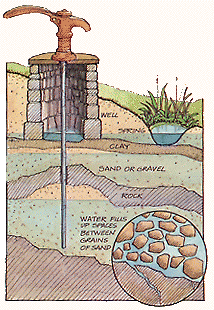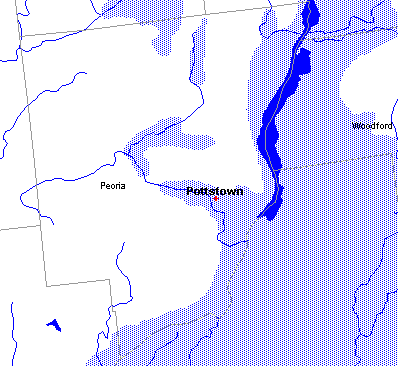One of the big arguments against an expanded toxic waste landfill is its location. It’s positioned over the Sankoty (sometimes written “San Koty”) aquifer. If you’re like me, you probably don’t remember a whole lot of that geology stuff from grade school or high school and you’re thinking to yourself, “what the heck is an aquifer?” Here’s what I’ve found out.
Simply stated, an aquifer is a water-bearing layer of earth. In fact, the word “aquifer” comes from Latin: aqui- which means “water,” and -fer (from ferre) which means “to bear.” The New Oxford American Dictionary defines “aquifer” as “a body of permeable rock that can contain or transmit groundwater.”
Beneath our feet us here in Peoria, there is a layer of sand and gravel that is porous and saturated with fresh water. It’s about 100 feet thick and is, thus, an abundant source of water used for both irrigation and drinking water in the region. I couldn’t find much information on the name “Sankoty,” except that it’s apparently named after the water well field on the northeast side of Peoria (source: Illinois State Water Survey). Illinois American Water Company uses three well sites to draw from the Sankoty aquifer, which accounts for 60% of our tap water.
 The picture to the left (from the Gulf of Maine Aquarium website) shows a good cross-section of the different layers of earth and how a simple well is used to access the water in an aquifer. They describe how an aquifer works like this:
The picture to the left (from the Gulf of Maine Aquarium website) shows a good cross-section of the different layers of earth and how a simple well is used to access the water in an aquifer. They describe how an aquifer works like this:
[P]recipitation (both rain and snow) runs into lakes, rivers, ocean, or into underground storage areas called aquifers. Aquifers are underground reservoirs. The water that reaches these chambers is usually much cleaner than the water of reservoirs at the earth’s surface. Almost no bacteria live in aquifers. Many pollutants are filtered out as the water passes through the soil on its way to the aquifer.
Clearly, this is an important natural resource for our region and one that we don’t want to see contaminated. Naturally, the people at PDC are professionals and they are doing everything they can to keep the aquifer from being contaminated. But even they would agree that there is a risk of contamination, even though they would argue that the risk is very low.
Let’s take a look at where exactly this Sankoty aquifer lies. Since it’s beneath the surface, it’s hard to find a map of it. However, I finally discovered one on the National Atlas of the United States website:

The dark blue lines are above-ground bodies of water; the gray lines are county borders; and the shaded blue area is the Sankoty Aquifer that lies below the surface. I’ve notated Pottstown on the map so you can see exactly where the toxic waste dump is located in relation to the aquifer.
Note that the aquifer does not underlie all, or even most, of Peoria County. Thus, it’s conceivable that another site could be found in the county for the dump that wouldn’t risk our groundwater at all, rather than expanding in its current site. Ideally, the current toxic waste could be relocated away from the aquifer as well, although I suppose that’s not financially feasible.
The more I study this issue, the more I’m convinced the county should deny the landfill expansion. I just can’t see any benefit to putting our groundwater at further risk, however low PDC promises us that risk would be. I can’t think of a better example of an issue on which it would be better to err on the side of caution.

Great work. This is the first rational explanation I’ve seen.
I’m with you on this one, and I’m generally a pro-development kind of person. But the stakes are way too high on this one. One mistake or accident, however remote, could destroy our entire community for generations.
The world held its collective breath when Michael Jackson dangled his baby over the balcony’s edge. The chances he would drop the child were slim. Maybe even impossible, he thought. The rest of us, though, were scared to death. It COULD happen. And PDC — or some company that purchases them in 10 or 20 years — is wanting to do the same thing with our aquifer.
It’s just not worth it, however much money it could generate.
The problem with pictures like the last one, is that people think… “Mm if we just located it on a white spot all would be ok, no aquifer right?” Mm no… there are other aquifers at different depths. There is groundwater under virtually every location if you dig deep enough. No place is safe.
Another question I have, is why exactly were houses built so close to the landfill? That landfill is older than the neighborhoods abutting it, correct? This makes me think of the people who go an build houses next to pig farms and then complain about the smell. Then turn around an try to have the pig farm shut down. If you didn’t want to live next to a pig farm, then why did you build or buy an house next to one? Same thing with this dump.
Everytime I see one of these NIMBY movements, I see hypocrisy all around. Rarely are meaningful solutions offered as alternatives. Instead it is just, put it somewhere else.
You never hear people say, “Gosh we will pay the extra future liability costs on the products we buy that are made with the chemicals that end up in a dump”. People like their everyday low Big Box Mart prices.
You never hear people say, “Lets make recycling mandatory and hold the manufacturer responsible for ensuring the environment is secure” Nope cause that would be too much government regulation.
You never hear people stand up and say; “Lets raise taxes so that we can properly fund EPA enforcement” Big government is bad.
You never hear people stand up and say; “We made this waste, we own this waste, we must find a way to dispose of it where we live.” Send it to another state, another country, another ocean… not our problem.
You never hear people stand up and say; “Look at all this trash!! Packaging, can’t something be done about it?!” Outlaw plastic bottles? Pfft. Lunchable containers? Pfft. Enough Celophane you wrap your house and make it fuel efficient. Pfft. God forbid anyone should be inconvenienced.
Don’t put it here please. Find someone somewhere who is politically weak and trash their neighborhood instead.
If they want to impress me, they should focus on it’s root origins, where and why the waste exists in the first place. If you don’t make the waste, you don’t need so much landfill.
Mahkno, it is true that there is water at all different depths, but the shallower aquifer is (a) from where we draw our tap water and (b) more at risk of contamination precisely because it is shallower.
I’m all for recycling, looking at root causes, and attacking the supply-side of toxic waste. In fact, my family does quite a bit of recycling thanks to my conscientious wife — and no thanks to Peoria which doesn’t do anything to make it easy to recycle around here. However, the issue at hand is whether to expand the landfill in its current location.
As far as “we made this waste, we own this waste,” etc., we actually only make and own 16% of the toxic waste in PDC’s landfill. The other 84% comes from other communities outside the county, including 10 other states. Shouldn’t those other communities own their waste, too? Or should our community own everyone’s waste?
If we were only dealing with our waste, they wouldn’t need to be expanding the landfill.
The objective of the NIMBY’s is to close the PDC hazardous waste dump completely and have it be dumped somewhere else. No local waste going there, no long distance waste going there, just put it somewhere else.
I am not seeing a proposal to limit the dump to only Illinois waste or better yet to Peoria County (or tri country) waste.
Those other long distance communities absolutely should own up and store their own generated waste in their own local areas. If it takes legislation to make that happen then it should be done, but don’t look for the NIMBY’s to push for that.
If PDC needs to expand the landfill to accomodate local waste and ONLY local waste, I am fine with that. Not happy.. but fine. That is the price you pay for living in an industrial world. I do think we the people need to focus more on the root causes and not harp so much at the complications caused by our negligence. The complications will never go away until you deal with the originating problem.
So not allowing to PDC to expand, what is your proposal, or the anti-PDC group’s solution? If they can’t offer one, then they need to back off. Offer me an answer, not a reaction. I see this as more and more of the way that these extreme thinking groups operate. It’s not enough that they can drive industrial jobs out of communities, or regulate to death those same companies, there-by forcing them to relocate to countries more open to their “toxins” and in return, we lose jobs, allowing the dangers to be someone elses concern, etc.
Maybe it’s time we take responsability for what we create. I know you all flush the toilet, buy batteries for your car, cell phones, remotes and more. You have CVS, Walgreens and the battle star Walmart process your family pictures. I also imagine you see your family doctor, have made the occasional trip to the hospital, and more then not, have friends or relatives that work at Cat or Keystone or the host of other polluters of our area.
How about, you not use your car, your cell phone, take pictures, quit speaking to the people that work at the pollution producers. Quit allowing Waste Management, PDC or the garbage collection service pick up your garbage, and don’t flush your toilet. I would bet if just the folks that are looking to stop toxic waste from spreading did this, we would see a drastic decline for the need of more landfill space. I of course will continue to use all the above services, as I don’t oppose the landfill, so why should I change my lifestyle, though you seem to feel by stopping the the growth of the landfill will somehow protect our children.